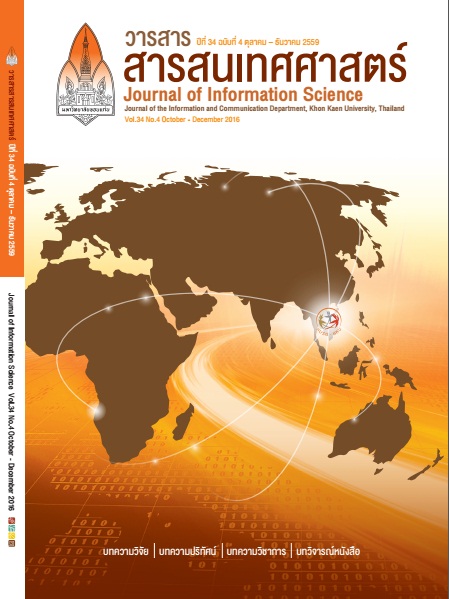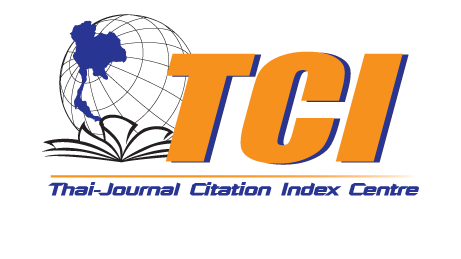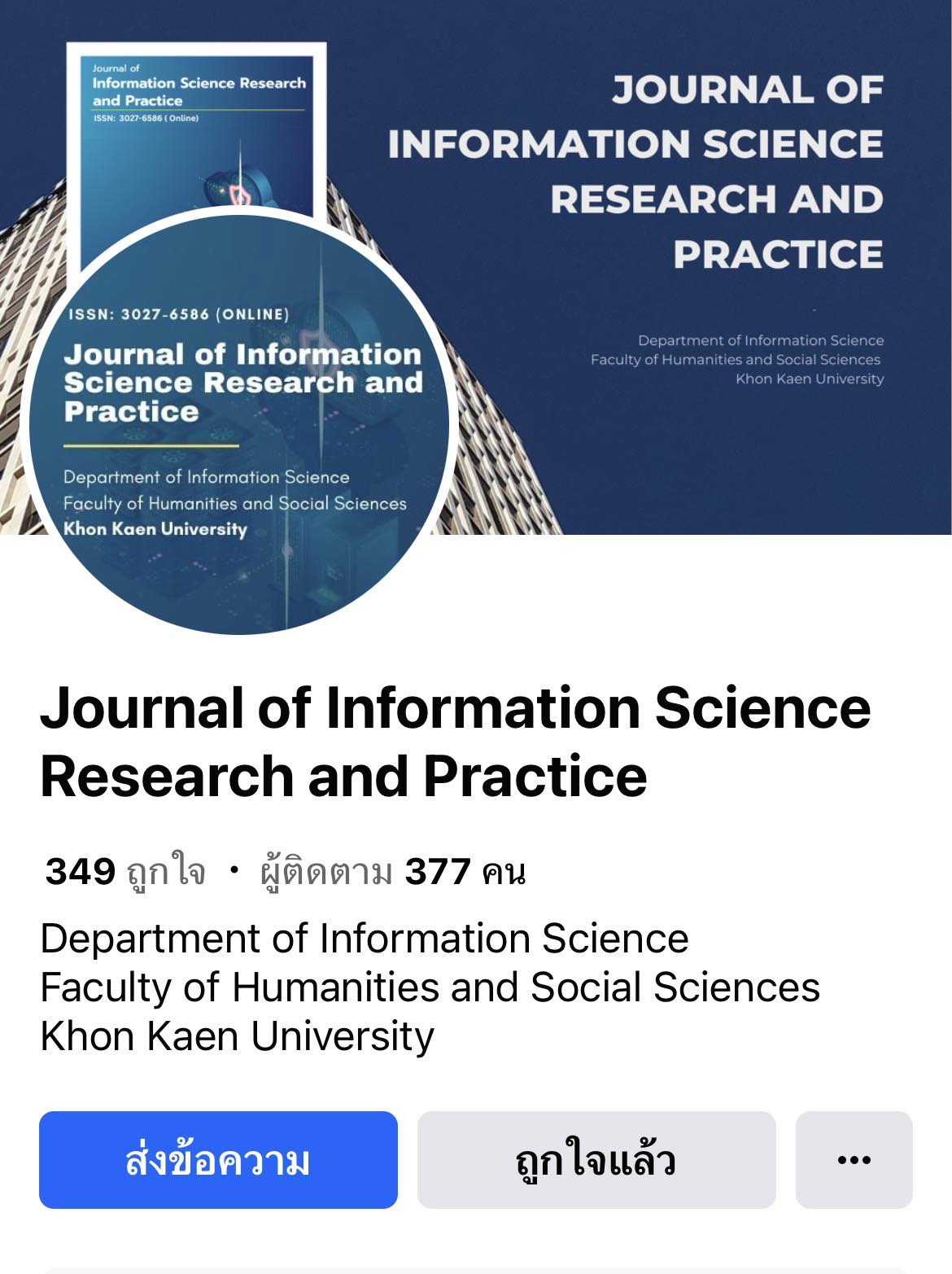การจัดการความรู้นาฏศิลป์พื้นบ้านล้านนา เรื่อง การฟ้อนสาวไหม
Keywords:
การจัดการความรู้, นาฏศิลป์พื้นบ้านล้านนา, การฟ้อนสาวไหม, Knowledge Management, Lanna folk dance, Fon Sao MaiAbstract
บทคัดย่อ
งานวิจัยนี้มีวัตถุประสงค์เพื่อศึกษารูปแบบและกระบวนการฟ้อนสาวไหมแบบมาตรฐานจากแม่ครูบัวเรียว รัตนมณีภรณ์ โดยใช้กระบวนการจัดการความรู้ และผลิตสื่อการสอนนาฏศิลป์พื้นบ้านล้านนาเรื่อง การฟ้อนสาวไหมผ่านเครือข่ายอินเทอร์เน็ต ใช้วิธีการวิจัยเชิงคุณภาพโดยการประยุกต์แนวคิดโมเดล SECI ในการสกัดความรู้ฝังลึกการฟ้อนสาวไหมจากผู้เชี่ยวชาญ จำนวน 3 คน และจัดทำเป็นความรู้ชัดแจ้งในรูปแบบลายลักษณ์ ภาพนิ่ง วีดิทัศน์ และเว็บไซต์ สำหรับการวิจัยเชิงพัฒนาได้ผลิตสื่อการสอนนาฏศิลป์พื้นบ้านล้านนาเรื่อง การฟ้อนสาวไหมผ่านเครือข่ายอินเทอร์เน็ต (http://www.kmfonsaomai.com) เครื่องมือที่ใช้ประเมินประสิทธิภาพการใช้งานระบบและประสิทธิผลการจัดการความรู้ของระบบ คือ แบบสอบถามออนไลน์ วิเคราะห์ข้อมูลเชิงปริมาณโดยหาค่าเฉลี่ยและส่วนเบี่ยงเบนมาตรฐาน
ผลการวิจัยสรุปว่า รูปแบบการฟ้อนสาวไหมแบบดั้งเดิมของแม่ครูบัวเรียว รัตนมณีภรณ์ มีจำนวน 13 ท่า ได้แก่ ท่าไหว้ (เทพพนม) ท่าบิดบัวบาน ท่าพญาครุฑบิน ท่าสาวไหมช่วงยาว ท่าม้วนไหมซ้าย-ขวา ท่าตากฝ้าย ท่าม้วนไหมใต้เข่า ท่าม้วนไหมใต้ศอก ท่าพุ่งหลอดไหม ท่าสาวไหมรอบตัว ท่าคลี่ปมไหม ท่าปูเป็นผืนผ้า และท่าพับผ้า สำหรับกระบวนการฟ้อนสาวไหมเป็นการร้อยเรียงท่าฟ้อน 13 ท่าเข้าด้วยกันตามลำดับอย่างเชื่อมโยงทั้งท่าเดิน ท่านั่ง และท่ายืนที่อ่อนช้อยและสวยงาม ทำให้ผู้ชมเห็นภาพขั้นตอนและความต่อเนื่องของการเก็บฝ้าย การปั่นฝ้าย การดึงด้ายแต่ละเส้น จนกระทั่งการทอผ้าเป็นผืน
ผลการประเมินสื่อการสอนนาฏศิลป์พื้นบ้านล้านนาเรื่อง การฟ้อนสาวไหมผ่านเครือข่ายอินเทอร์เน็ตของผู้ตอบแบบสอบถาม จำนวน 4 กลุ่ม พบว่า ผู้เชี่ยวชาญจำนวน 3 คน ผู้ดูแลระบบจำนวน 2 คน ครูจำนวน 4 คน และลูกศิษย์จำนวน 26 คน เห็นว่า การใช้งานระบบมีประสิทธิภาพระดับมาก (ค่าเฉลี่ย = 3.54, 3.85, 4.05 และ 4.36) ด้านผลการประเมินประสิทธิผลการจัดการความรู้ของผู้ใช้ระบบ จำนวน 3 กลุ่ม คือ ครูเห็นว่าระบบมีประสิทธิผลระดับมากที่สุด (ค่าเฉลี่ย = 4.65) ส่วนผู้เชี่ยวชาญและลูกศิษย์เห็นว่าระบบมีประสิทธิผลระดับมาก (ค่าเฉลี่ย = 3.61 และ 4.30)
ABSTRACT
The purposes of this research and development study were 1) to investigate the tacit knowledge of the Lanna (Northern Thailand) folk dance - Sao Mai (weaving dance), developed and styled by Teacher Buariao Rattanamaneeporn, applying SECI Model for qualitatively extracting the tacit knowledge from 3 scholars, and 2) to transform the tacit knowledge to explicit knowledge in the forms of texts, pictures, videos and website. In addition, a knowledge system was developed using Joomla program for creating the knowledge database and the website (http://www.kmfonsaomai.com). Two sets of online questionnaire were used for system evaluation of both efficiency and effectiveness. Qualitative data were analyzed using mean (x̄) and standard deviation.
Results of the research revealed that the Buariao Rattanamaneeporn traditional pattern of Fon Sao Mai consisted of 13 postures: Tha Wai (Theppanom), Tha Bitbuaban, Tha Phrayakrutbin, Tha Saomaichuaengyao, Tha Muanmaisai-kwa, Tha Takfai, Tha Muanmaitaikao, Tha Muanmaitaisok, Tha Poonglordmai, Tha Saomairobtua, Tha Kleepommai, Tha Pupenphuenpha, and Tha Pabpha. Furthermore, the Fon Sao Mai was a series of integrating the 13 postures of sitting, standing and walking to form a slow and graceful dance movement expressing the continuous process of cloth weaving.
The system evaluation by 3 experts, 2 system administrators, 4 teachers and 26 students found that the system efficiency ranked at a high level. (x̄ = 3.54, 3.85, 4.05 and 4.36). Regarding the effectiveness of knowledge management, teachers’ evaluation ranked the highest (x̄ = 4.65) followed by those of experts and students (x̄ = 3.61 and 4.30).








